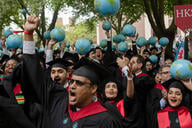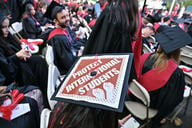International Students by the Numbers
Since taking office in January, President Donald Trump and his administration have acted aggressively against international students, including instituting widespread changes to their legal status and implementing entry bans on nationals of specific countries or for scholars at certain institutions.
To put into context the role of international students in U.S. higher education and their added value to the U.S. economy, Inside Higher Ed compiled five key statistics about them.
1. International students are 1.1 million strong, making up 6 percent of U.S. enrollments.
The U.S. hosts the largest share of international students globally (16 percent), welcoming 1.1 million learners in 2024, according to the Institute of International Education. About 242,700 visitors to the U.S. are on Optional Practical Training, or OPT for short, according to IIE data.
While the U.S. welcomes the largest number of international students, these students make up a fraction—about 6 percent—of the country’s total enrollment. By comparison, Canada welcomed 840,000 international students in 2024, or 39 percent of the country’s total postsecondary enrollment.
2. Two percent of international students have been impacted by new travel bans.
As of Monday, nationals of 12 countries have been barred from entering the United States, and those from seven more countries face significant visa restrictions. The ban, announced in a June 5 executive order from President Trump, will impact students from Afghanistan, Cuba, Haiti, Iran, Turkmenistan and Venezuela, among others.
About 25,000 students from these countries were studying in the U.S. as of March 2024, according to data from the Department of Homeland Security analyzed by Inside Higher Ed. Approximately one in five of them was participating in a bachelor’s program, and 38 percent were enrolled in a doctoral program.
If the Trump administration succeeds in reducing the number of Chinese students who can participate in U.S. higher education, the impacts may be more dramatic on enrollment; Chinese international scholars numbered 255,146 in March 2024, according to DHS data.
3. California is the No. 1 host among states.
Among the 50 states, California welcomes the greatest share of international students each year—just over 140,800 as of the 2023–24 academic year, according to NAFSA, the national organization for international educators. New York is close behind (135,800 students), followed by Texas (89,500 students) and Massachusetts (82,306 students).
On the opposite end, Montana and Wyoming hosted fewer than 1,000 international scholars apiece, and fewer than 300 international students made their way to Alaska in 2023–24 (and about 50 of those students were from Canada, according to DHS data).
4. NYU is the campus with the most global scholars.
Demonstrating that New York City lives up to its reputation as a melting pot, New York University enrolls the greatest number of international students of any U.S. college or university, totaling 27,247 during the 2023–24 academic year, according to data from IIE. International students make up about 44 percent of NYU’s student population, compared to Northeastern University in Boston, where international students are fewer in number but make up closer to two-thirds of the campus population (21,000 of 31,000 learners).
Among two-year colleges, Texas community colleges lead the way. Houston Community college enrolls the most international students (3,629), followed by the Lone Star College system (3,196) and Dallas College (2,305), as of 2023–24 figures.
5. International students added $43.8 billion to the U.S. economy last year.
According to NAFSA, international students contributed $43.8 billion to the U.S. economy during the 2023–24 academic year. That’s a pretty big number. To put it in perspective:
- Waymo, the company behind self-driving cars in some parts of the U.S., is valued at $45 billion.
- The country of Estonia’s gross domestic product in U.S. dollars is $41.29 billion, as of 2023.
- Target has a $44 billion market capitalization, as of June 6.
- Ken Griffin, hedge fund manager and founder of Citadel, is worth around $42.3 billion, and Stephen Schwarzman, co-founder of private equity firm Blackstone, is worth $44.4 billion (that’s about 27 Taylor Swifts).
- Walt Disney World Resort generated $40.3 billion in economic impact across Florida in fiscal year 2022.
Through their tuition, international students support nearly 400,000 jobs at colleges and universities, as well as through spending on housing, food, retail and other living expenses, according to NAFSA.
More Coverage of International Students in 2025
- International Students Hit with Back-to-Back Orders
- Where International Students Stand Now
- Attacks on Chinese Students Could Wreck Havoc on Higher Ed
- What Is SEVIS, and How Is the Government Using It to Go After International Students?
- State Department Will Vet Student Visa Applicants’ Social Media
- Trump Administration Strips Harvard’s SEVP Certification
- Trump Admin Downplays Impact of Terminating International Students From Key Database
- ICE Threatens OPT Visa Holders With Deportation
- Smashing the Student Visa System
- International Enrollment’s Precarious Moment
- ‘Palpable Fear’ Hangs Over International Students




